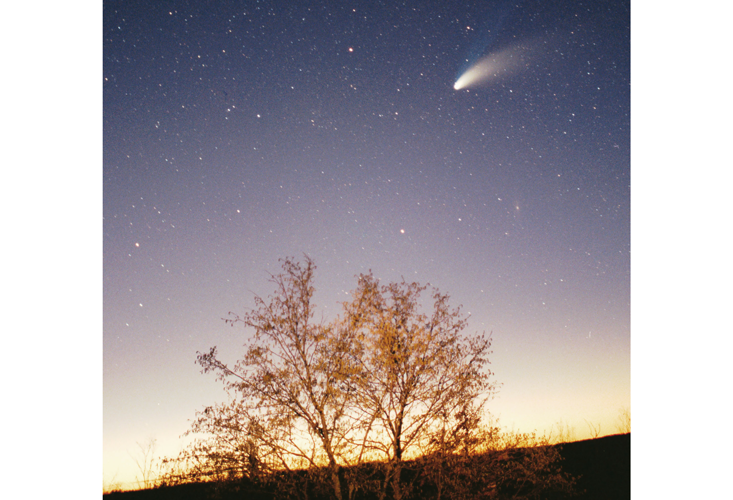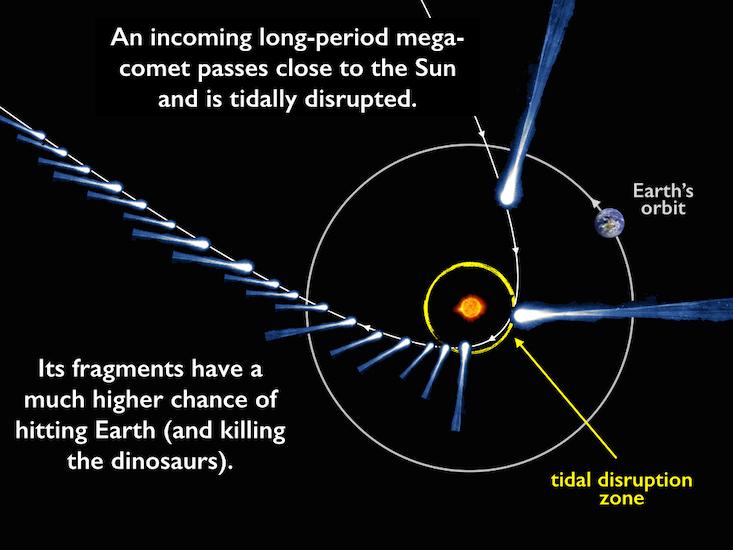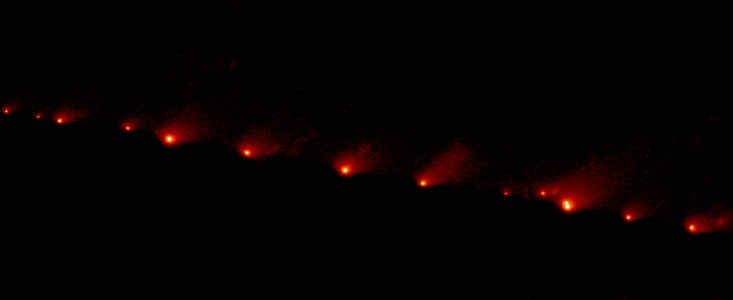You know what the plot of a show called CSI: Chicxulub would be? Finding out what killed the dinosaurs, of course. There’s now no question that the scene of the “crime” was the Yucatan Peninsula, in Mexico, where researchers found a massive crater. But what was the murder weapon—an asteroid, or a comet? A trivial difference, you might think, like whether that chocolate on the sidewalk is a smashed-up Snickers or Kit Kat bar. But knowing what sort of thing struck the Earth near the modern town of Chicxulub, clearing the way for mammals to rise up, affects how astronomers evaluate cosmic dangers to our planet.
Now comets, as you may know, come from far away, and spend little time in the inner solar system. Scientists, based on decades of work, consider it to be a minor risk for one to collide with Earth. A new study, however, hints that comets pose a much greater threat than previously thought.1 Specifically, it’s the long-period, rather than the short-period ones, we have to look out for.
Long-period comets are the least likely to hit our planet because they visit the inner solar system rarely (often just once) and zip by so quickly that the Earth is a tiny target. They originate in the Oort cloud, which extends several light-years from the sun (out to 200,000 times the Earth-sun distance) to the edge of the solar system. Most objects from the Oort cloud will never pass close to the sun, but the few that do can light up our skies. As they warm up and their ices vaporize, they create bright comae and tails. Comet Hale-Bopp was a dazzling sight when it passed through the inner solar system in 1997.

These comets are barely gravitationally bound to our star. Galactic forces, such as the combined gravity of unevenly distributed dust and gas clouds, nudge them toward the inner solar system. Short-period (or Jupiter-family) comets, on the other hand, originate in the Kuiper belt, leftover icy material past Neptune’s orbit. On their way into the inner solar system, Neptune’s gravity slingshots them, kicking them outward. As they come back for another pass, they eventually move inward toward Uranus, which, with Saturn, repeats this process, handing objects off to Jupiter, the dominant mass of the solar system (apart from the sun of course). Once a comet is in Jupiter’s clutches, the clock is ticking until it passes too close to Jupiter and is launched out of the solar system. There is a time window in which a comet can collide with Earth, but it is narrow, and impact rates are low.
In the new study, published in Scientific Reports, Harvard astrophysicists Amir Siraj and Avi Loeb (yes, the backer of that controversial hypothesis about aliens) add a wrinkle to this story. They calculate that about 20 percent of long-period comets that pass within Earth’s orbit pass so close to the sun that they are torn apart by tidal forces. This process creates long strands of comet fragments that vastly increase the odds of collision with the Earth.
It’s likely quite common for comets passing close to the sun to be tidally disrupted. Scientists know several groups of comets that are likely tidal fragments. For example, the Kreutz group contains thousands of comets stretched along similar orbits around the sun that are thought to be the remnants of a single giant comet that disrupted a thousand or more years ago.

From the Chicxulub crater, scientists can tell that the impactor had a diameter of about 12 kilometers. Sediments found beneath the crater contained material usually associated with asteroids. This wouldn’t be surprising. Astronomically speaking, most of the stuff that bashes Earth comes from close by, in the inner part of the asteroid belt, the closest source of loose objects. Indeed, rocks that have been spectrally associated with asteroids dominate our meteorite collections.
These meteorites are so commonplace that we call them “ordinary” chondrites, or stony meteorites. The light reflected from most meteorites looks just like the light we see when we point our telescopes at the inner parts of the asteroid belt. Unstable orbital resonances crisscross this belt, and when an asteroid enters one of these resonances, the planets (usually Jupiter) strongly perturb its orbit, progressively stretching it out until it becomes more and more elliptical, or “eccentric.” This propels asteroids from the inner part of the belt into the realm of the rocky planets, whereas outer-belt asteroids usually end up too close to Jupiter and are thrown out of the solar system entirely. Many close-in asteroids collide with the sun, and a fraction hit the Earth.
It’s now “indisputable” that an asteroid killed the dinosaurs.
A 2007 study proposed that an asteroid associated with the Baptistina family from the inner belt, created by the breakup of a larger object (probably from a collision between asteroids) about 160 million years ago, was the dinosaur killer.2 A member of that asteroid family supposedly entered an unstable resonance with Jupiter and was kicked into the inner solar system, eventually colliding with Earth 65 million years ago. Yet the sediments left behind after the collision suggest what struck our planet was unlike ordinary chondrite meteorites, and more similar to carbonaceous chondrites, associated with a different class of asteroids (that more often come from the outer belt).
It was thought that the Baptistina family was similar in composition to carbonaceous chondrites, but later work showed that these asteroids were more likely similar to ordinary chondrites. The timing of the Baptistina breakup was also moved much sooner, about 80 million years ago, leaving only a narrow time window for impact. So the Baptistina asteroid theory is no longer a great match to the dinosaur killer. Of course, this doesn’t discount asteroids entirely. Another carbonaceous asteroid could plausibly have done the job.
And that’s precisely what a recent study, published in Science Advances, suggests.3 Joanna Morgan, a coauthor of the paper, told The Times that it’s now “indisputable” that an asteroid, about 12 kilometers in diameter, killed the dinosaurs.4 One of the sediment cores recovered from the impact site “contains an extremely well-preserved record of the immediate aftermath of the Chicxulub impact event within the crater that can be disentangled using various geochemical tracers,” the researchers wrote. “By applying these tracers, the effects of asteroid impacts on the biosphere and global environment in the first months to millennia of the Cenozoic Era as well as the fate of the Chicxulub impactor are unraveled in unprecedented detail.”
Asteroids large enough to kill the dinosaurs have been shown to hit Earth about once every 350 million years. Without accounting for tidal disruption, long-period comets have such low impact probabilities that only one dinosaur killer would have struck Earth since its formation. However, after taking disruption into account, Siraj and Loeb find that the rate of such impacts is about the same as for asteroids. The same process would not boost the impact rate of asteroids, however, because asteroids are too dense to easily disrupt.
Siraj and Loeb’s alternative comet-breakup model requires an incoming comet that has a diameter of at least 40 to 60 kilometers. That’s a monster, about the size of New York City, from the southern tip of Staten Island to the northernmost point of the Bronx (an hour-long drive in the best-case scenario), but not unprecedented, actually about the same size as comet Hale-Bopp. It’s not easy to estimate the sizes of the fragments that a comet that size would produce after it disrupts, but Siraj and Loeb calculate that they will be about 7 kilometers in diameter—the right size for the dinosaur killer.
While provocative, the new model involves considerable uncertainty. All signs point to asteroids being responsible for most impacts in the inner solar system—at least, for the ones we can see. Distributions of crater sizes on Mercury, the moon, and Mars all reflect the size distribution of near-Earth asteroids, suggesting that those are the objects that have crashed down on the planets (including on Earth, where most craters have been buried by geological activity or covered up by erosion).
The comet model also requires that a huge number of fragments be created every time a monster comet disrupts from passing close to the sun. Simulations find that a disrupted body is tidally stretched out into long strands that re-agglomerate into about 10 to 20 objects.5 These simulations match the natural demonstration of comet Shoemaker-Levy 9’s disruption into about 20 pieces after passing too close to Jupiter, in 1992. It is worth noting that the thousands of comets in the Kreutz family are thought to have been produced through a series of disruption events, rather than a single one. In contrast, the new model needs hundreds to thousands of fragments to be produced in order to increase the collision probability of comets enough to be on the same level as that from asteroids.

Then there’s the element iridium. Extensive geological digs around the world show that, in the aftermath of the impact, a striking layer of iridium-rich material was deposited. Since iridium is so rare on Earth—it’s “highly-siderophile” (iron-loving), so almost all of Earth’s iridium is in the planet’s core—scientists think the stuff came from space. The dinosaur killer must have contained enough to leave a global iridium-rich layer across the whole Earth.
Would a comet contain enough? It depends on what the comet was made of. There aren’t a lot of pieces of comets to test, but the samples returned from Comet Wild-2, courtesy of NASA’s Stardust mission, found that they were very similar to carbonaceous chondrite meteorites, which are known to contain iridium (although somewhat less than ordinary chondrites). Presumably the iridium level of a cometary object wouldn’t be that far off, but it remains to be seen.
This leaves us with a foot in no-man’s land. While the Baptistina source has dried up, carbonaceous asteroids are abundant enough to represent a plausible asteroid impactor, and would match all of the data. That doesn’t completely rule out Siraj and Loeb’s cometary idea, because as tidal disruption increases the number of comets (by producing fragments) it also increases the odds of them crashing into the planets—a twist future calculations on impact probabilities must take into account.
What’s evident, even if one didn’t “off” the dinosaurs, is that it’s safe to assume that comets, shattered into shards by the sun’s gravity, pose what was an underappreciated threat.
Sean Raymond is an American astrophysicist working at the Bordeaux Astrophysical Laboratory in France. He also writes a blog at the interface of science and fiction, and recently published a book of astronomy poems.
References
1. Siraj, A. & Loeb, A. Breakup of a long-period comet as the origin of the dinosaur extinction. Scientific Reports 11, 3803 (2021).
2. Staff writers. The Baptistina breakup. Astrobiology Magazine (2007).
3. Goderis, S., et al. Globally distributed iridium layer preserved within the Chicxulub impact structure. Science Advances 7, eabe3647 (2021).
4. Blakely, R. Asteroid dust linked to Chicxulub crater confirms dinosaur extinction theory. The Times (2021).
5. Stephens, T. New formation theory explains the mysterious interstellar object ‘Oumuamua. News.ucsc.edu (2020).
Lead image: solarseven / Shutterstock


























